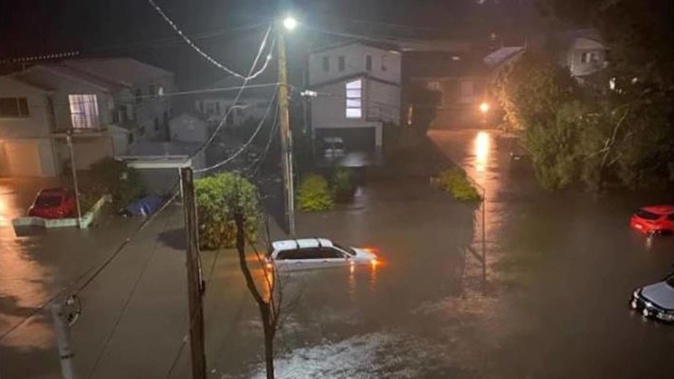
Unprecedented wildfires in Alaska. A collapsed glacier in Italy. Another intense US heatwave. The fourth flood in NSW since March …
Extreme weather events are battering our planet. And it points to a costly – and deadly – future.
Get used to it, scientists say. It's our artificial new normal.
The atmospheric tides and currents that drive our weather are intensifying and changing course.
Weather is nature's heat pump – an attempt to balance temperatures around the globe. But those shifts are becoming more rapid and pronounced as the atmosphere gets hotter.
The extreme heat in Europe, the US and Asia this northern hemisphere summer represents the changing course of the jet streams – intense but narrow westerly winds that circle the globe.
It's a similar story down south. Shifting currents are streaming over Antarctica, causing it to warm at four times the average of the rest of the planet.
/cloudfront-ap-southeast-2.images.arcpublishing.com/nzme/EBX7RP3OPZDBSPMLBJPJXOKTT4.jpg) Image of the Kwethluk fire in Alaska in April this year. (Photo / Matt Snyder/Alaska Department of Forestry/Facebook)
Image of the Kwethluk fire in Alaska in April this year. (Photo / Matt Snyder/Alaska Department of Forestry/Facebook)
When these jets change course, heat domes can form in one place and extreme precipitation bubbles in another. But, mostly, it means the regular weather patterns people have become used to over the centuries are falling apart.
And the consequences are unfolding before our eyes.
North American wildfires
The snow is melting earlier every year. Every year, it settles back on the ground later. That means Alaska's enormous forests are drier than ever before.
But changing weather patterns means the type of weather the arctic frontier is experiencing has changed. The warm jet stream is moving north. And it's bringing tropical storms with it.
And that means lightning.
Between July 2 and 4, Alaska experienced some 17,770 lightning strikes. It's the most intense spate ever recorded for the region.
And that lightning has been striking a tinderbox.
Some 930,000 hectares have so far been scorched. It's charting a course to become yet another record-breaking year. And the fires are erupting in ecosystems that have until now remained relatively untouched. The treeless tundras of southwestern Alaska are also ablaze.
The hot and dry weather has also extended into Canada.
Last week, Vancouver reported more than 130 sudden deaths over three days. It reached its highest ever recorded temperature – 49.6C. Now new wildfire warnings are being issued in the pristine Yukon region.
A dangerous "heat dome" is now building in the south-central United States.
Texas has already been setting all-time heat records. Now extreme temperature warnings have been issued to 65 million people from Austin to Des Moines. Other prominent cities such as Helena, Nashville, Kansas City and Chicago will soon fall within its embrace.
Glacier collapse
Europe is in the grip of a heatwave. And the heatwave that set all-time temperature records in Italy is not just withering crops and sending its population to the beaches.
The hot air has been pushing ever higher. And that's eroding long-established snow lines – and undermining glaciers.
The day before the devastating Marmolada glacier collapse in the Italian Alps, temperatures of 10C were recorded at its 3400ft (1036m) summit. That's never been seen there before.
/cloudfront-ap-southeast-2.images.arcpublishing.com/nzme/M3J7JESUBFI7LBBEGL5VRZ2EKM.jpg) A general view of the flooded Windsor Bridge along the Hawkesbury River in the suburb of Windsor, on July 4, 2022 in Sydney, Australia.
A general view of the flooded Windsor Bridge along the Hawkesbury River in the suburb of Windsor, on July 4, 2022 in Sydney, Australia.
With the soil beneath the steep ice becoming slick with mud, a massive chunk broke off. The heavy avalanche accelerated downslope to speeds of up to 300km/h.
"Glacier decline has been accelerating across the Alps over the last few decades due to global heating making the high mountains of Europe an increasingly dangerous and unpredictable environment to be in," warns University of Bristol Professor Jonathan Bramer.
Seven hikers are dead. Many more remain missing. And mountain dwellers and the tourism industry have begun looking at the shrinking ice fields with dread.
They're not the only ones. Glacial melt is rapidly becoming a problem worldwide. The most recent IPCC report warns permafrost temperatures are rising everywhere, from the European Alps and Scandinavia to Canada and Asia.
Switzerland, Austria, France and Germany have initiated glacier monitoring programmes to assess the risk of collapse. Other nations may have to follow suit.
"The Marmolada glacier collapse is a natural disaster linked directly to climate change," says Professor Poul Christoffersen of the University of Cambridge.
"High elevation glaciers such as the Marmolada are often steep and rely on cold temperatures below zero degrees Celsius to keep them stable."
Flood events
New South Wales has some 50,000 residents under flood evacuation orders after a weekend of intense rainfall. But Sydney's not the only victim of extreme floods.
In June, storms dumped more than 12cm of rain on Yellowstone National Park. Combined with rapidly melting snow, creeks and rivers quickly burst their banks – destroying roads and buildings and forcing 10,000 people to evacuate.
It's just another example of a rapidly escalating trend.
"The fact that the world has experienced multiple record flooding events in recent years – including catastrophic flooding in Australia, Western Europe and China – is not a coincidence," says Colorado State University researcher Dr Frances Davenport.
"Three effects of climate change, in particular, are creating higher flood risks: more intense precipitation, shifting snow and rain patterns and the effects of wildfires on the landscape."
The warmer the air, the more moisture – humidity – it can hold. Every 1C increase represents an extra 7 per cent increase in potential rainfall.
That also means regions that usually experience precipitation as snow are getting it delivered as heavy rain. And fire-affected areas often change in ways that allow less rain to permeate the soil – increasing runoff into streams and rivers. That worsens flood risk.
"This combination of wildfires followed by extreme rain will also become more frequent in a future with more warming," warns Davenport.
Asian extremes
China and Japan are also in the grip of a heatwave. And record temperatures – one Japanese city topped 40C – are combined with historic rainfalls.
Tokyo authorities have had to ask businesses and homeowners to reduce their power usage after nine days of record temperatures. Airconditioning demands threaten to topple the grid.
It's the longest heatwave since records began in 1875. And the first time 40C has been reached in June.
At the same time, heavy thunderstorms and intense rain are lashing the southern Japanese islands. It has set new rainfall records – with one town recording 37cm within 12 hours.
Record temperatures have also been experienced in Shanghai and Beijing.
Meanwhile, heavy rainfall is lashing the country. The provinces of Shandong, Jilin and Liaoning all experienced record rainfall in June. And that's exacted a damaging toll on infrastructure, crops and the environment.
The reasons there are the same as in Australia, the United States and Europe. Warmer air can hold more moisture.
"As the Yellowstone area and other flood-damaged mountain communities rebuild, they will have to find ways to adapt for a riskier future," concludes Davenport.
Take your Radio, Podcasts and Music with you









